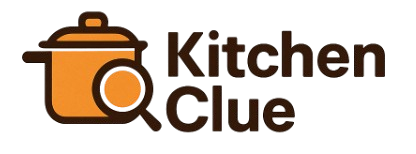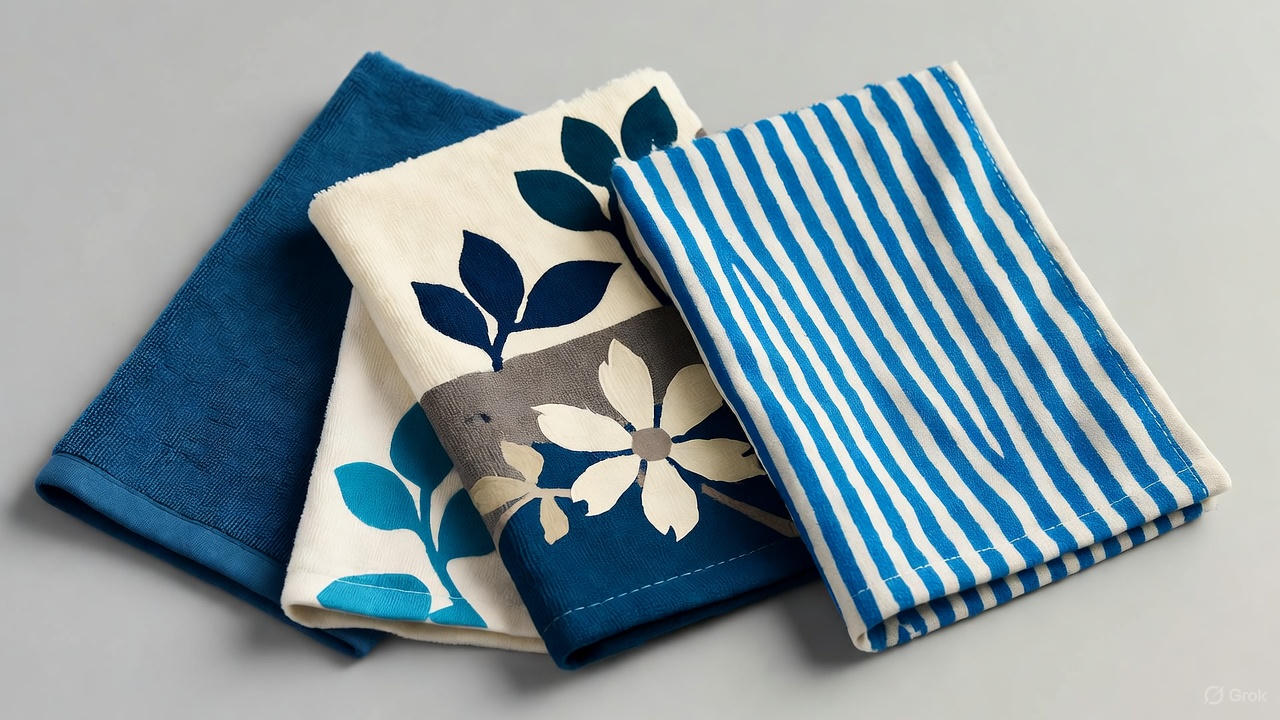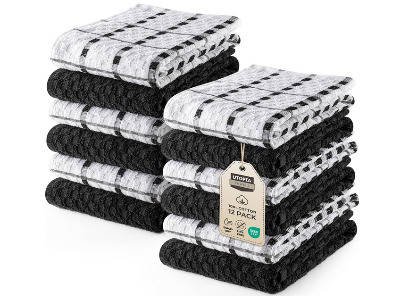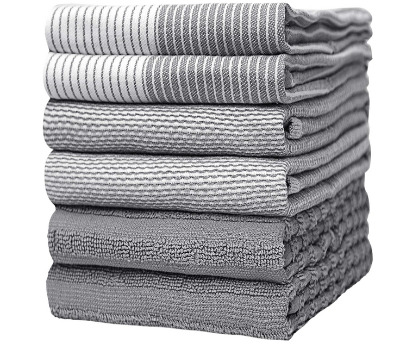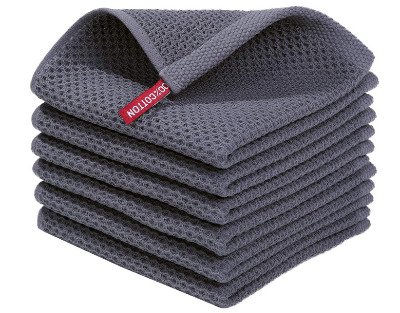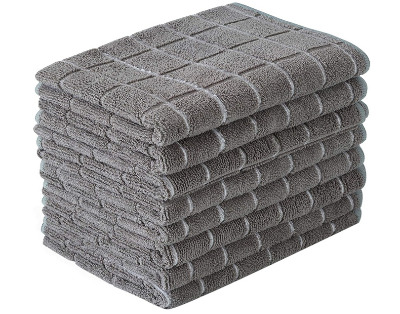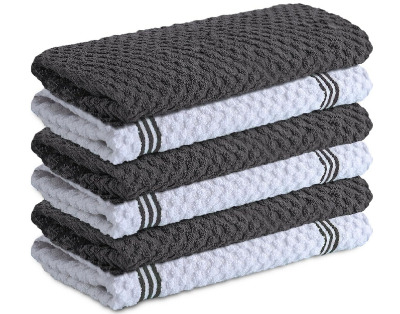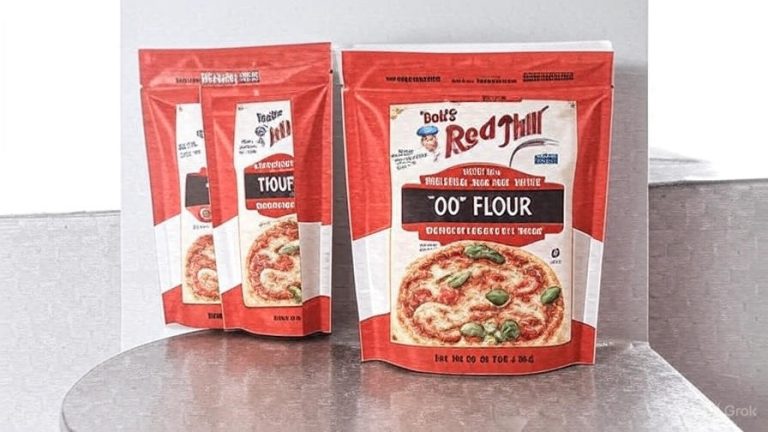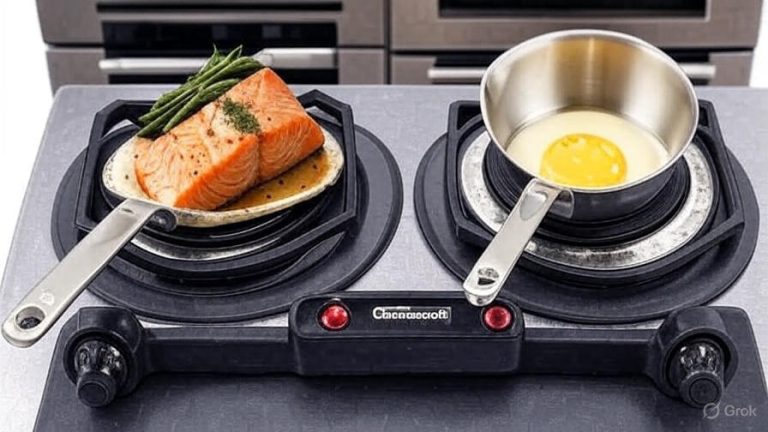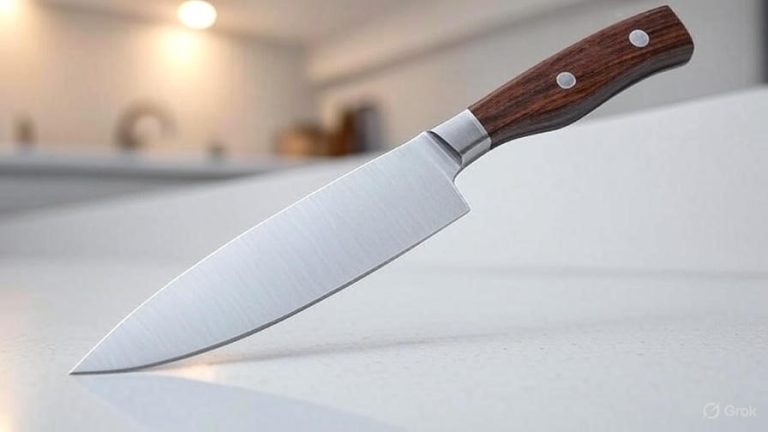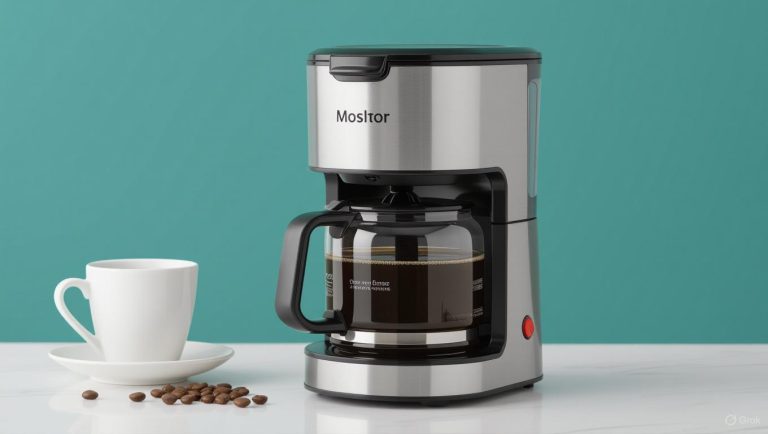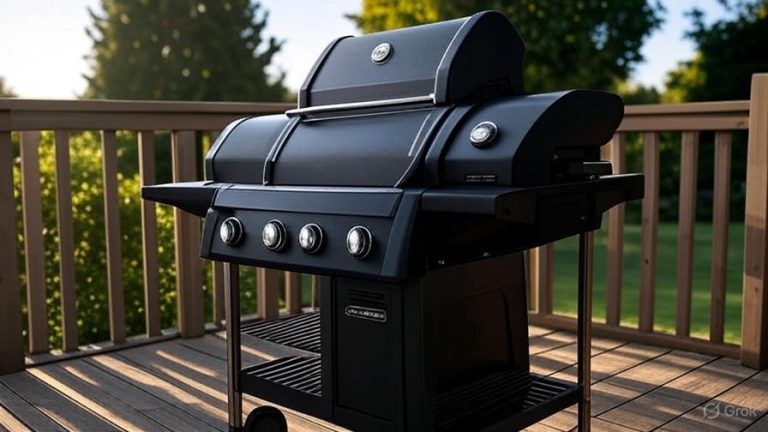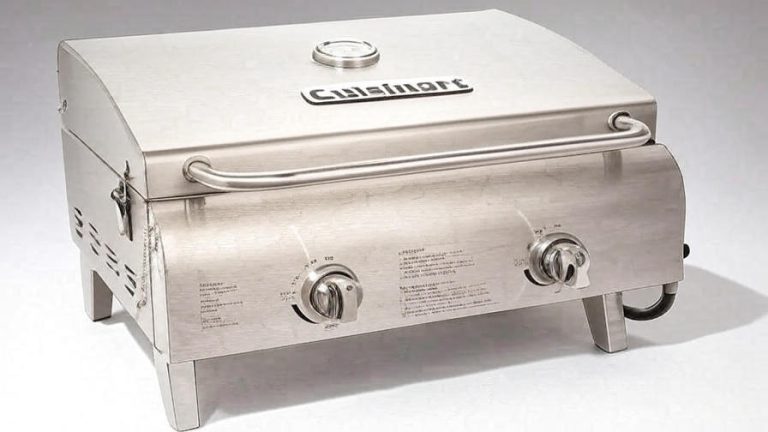5 Best Absorbent Dish Towels In 2025
Walking into a kitchen store or browsing online for dish towels can feel overwhelming. Shelves overflow with options promising supreme absorption, durability, and softness. Yet, not all kitchen towels deliver on these promises. After countless spills, endless dishes, and more than a few disappointing purchases, finding truly absorbent dish towels becomes a priority for anyone who spends time in the kitchen.
The right dish towel does more than just dry dishes. It tackles spills, wipes down counters, handles hot pots, and endures daily washing without falling apart. Quality kitchen towels transform routine cleaning tasks from frustrating to effortless. They absorb liquid quickly, dry faster, and maintain their integrity through hundreds of wash cycles.
This comprehensive guide examines five exceptional dish towel options that stand out in today’s market. Each product brings unique strengths to your kitchen, from classic cotton terry to innovative microfiber technology. Whether you need bulk sets for high-traffic kitchens or specialized towels for specific tasks, these options cover every need.
Why Absorbency Matters in Kitchen Towels
A dish towel that can’t absorb water properly becomes useless quickly. Water beads on the surface instead of soaking in, leaving streaks on glassware and puddles on countertops. Poor absorbency means reaching for multiple towels to complete simple tasks, creating unnecessary laundry and frustration.
Highly absorbent towels work because of their fiber structure and material composition. Natural fibers like cotton contain tiny spaces between threads that capture and hold water molecules. The weave pattern affects how much liquid the towel can handle. Terry cloth, waffle weave, and flat weave each offer different absorption characteristics suited to various kitchen tasks.
The best kitchen towels balance several factors: they soak up water rapidly, hold significant liquid volume, dry quickly between uses, and resist developing musty odors. These qualities depend on material choice, thread count, weave style, and construction quality. Understanding these elements helps distinguish truly superior products from mediocre alternatives.
Utopia Towels Kitchen Towels – Classic Reliability in Bulk
The Utopia Towels 12-pack brings traditional cotton terry construction to kitchens needing dependable workhorses. Each towel measures 15 by 25 inches, providing ample surface area for drying dishes, hands, and counters. The 100% ring spun cotton construction creates soft fibers that feel gentle against hands while maintaining robust absorbency.
Ring spun cotton undergoes a spinning process that twists and softens cotton fibers, creating stronger threads than conventional spinning methods. This technique produces towels that resist pilling and maintain their structure through repeated washing. The black color offers practical advantages, hiding stains that appear on lighter towels while maintaining a sleek, modern appearance in any kitchen decor.
This 12-pack configuration suits large families, busy households, or anyone who prefers having clean towels readily available. Having a dozen towels means less frequent laundry runs while ensuring fresh towels stay within reach. The set handles everything from drying delicate glassware to mopping up major spills without requiring constant washing.
The terry cloth construction features loops of thread that create a plush, absorbent surface. These loops increase the fabric’s surface area dramatically, allowing each towel to capture and hold more water than flat weaves of similar size. The towels work equally well for drying hands, dishes, or wiping down appliances after cooking.
Users appreciate how these towels soften with each wash rather than becoming rough or scratchy. Many cotton towels feel stiff initially but develop a luxurious hand feel after several wash cycles. The ring spun construction accelerates this process, delivering soft, comfortable towels that improve over time.
The generous size accommodates large pots, multiple plates, or extensive counter space. Smaller towels require folding or repositioning to cover adequate surface area. These 15 by 25-inch dimensions eliminate constant adjustment, making kitchen cleanup more efficient. The length proves particularly useful when laid across drying racks to accommodate several items simultaneously.
Black coloring conceals the inevitable stains that come with regular kitchen use. Coffee drips, tomato sauce splatters, and cooking oil spots disappear against the dark background, keeping towels looking presentable between washes. This practical benefit reduces stress about maintaining pristine white towels in active kitchens.
Premium Kitchen Towels – Versatile Flat and Terry Combination
The Premium Kitchen Towels set offers a strategic combination of flat and terry cloth designs in an impressive 20 by 28-inch size. This 6-pack delivers substantial coverage with each towel, making quick work of large surfaces and bulky items. The gray color provides a neutral, sophisticated look that complements any kitchen aesthetic while offering practical stain-hiding benefits.
These large cotton hand towels surpass standard sizes significantly. The extra dimensions mean fewer towels needed for big jobs and better coverage when drying oversized cookware. Commercial kitchens and serious home cooks benefit from towels that match the scale of their cooking ambitions.
The dual-construction approach includes both flat weave and terry cloth options within the set. Flat weave towels excel at polishing glassware, cleaning windows, and detailed drying where lint must be minimal. Terry cloth versions handle heavy absorption tasks like soaking up sink overflow or drying just-washed cookware. Having both types in one set eliminates the need to purchase separate specialty towels.
Each towel includes a hanging loop, a small detail that dramatically improves kitchen organization. Hooks, oven handles, or dedicated towel bars keep towels within easy reach while allowing air circulation for faster drying. Towels crumpled on counters stay damp longer, developing unpleasant odors. Proper hanging extends freshness between washes.
The cotton construction ensures natural absorbency without synthetic coatings or treatments. Pure cotton fibers soak up water through capillary action, pulling moisture into the fabric naturally. Chemical treatments can boost initial absorbency but often wash out over time, leaving towels water-resistant and essentially useless. These towels rely on material quality rather than temporary additives.
Gray represents an ideal middle ground between stark white and dark colors. It hides minor stains effectively while maintaining a clean, professional appearance. The neutral tone works with everything from modern minimalist kitchens to traditional country aesthetics. Coordinating kitchen textiles becomes simpler when colors remain versatile and timeless.
The six-towel count provides enough variety for weekly use without overwhelming storage spaces. Smaller sets require constant laundering, while oversized packs challenge kitchen drawers and cabinets. This quantity strikes a balance for average households, ensuring clean towels stay available throughout the week.
Homaxy Cotton Waffle Weave Dish Cloths – Quick-Drying Efficiency
The Homaxy waffle weave dish cloths introduce a different approach to kitchen absorbency. These 12 by 12-inch squares feature a distinctive textured pattern that enhances both water absorption and drying speed. The 6-pack of dark grey cloths combines practicality with modern design, offering 100% cotton construction in a compact, efficient format.
Waffle weave fabric creates a three-dimensional surface through its raised square pattern. This texture increases the fabric’s surface area dramatically compared to flat weaves of identical size. More surface area means more contact points for water absorption, allowing these relatively small towels to handle significant liquid volumes. The pockets in the weave trap water effectively, preventing dripping when moving the towel from sink to counter.
Quick drying represents a crucial advantage in busy kitchens. Towels that stay damp for hours become breeding grounds for bacteria and develop sour odors rapidly. The waffle weave’s texture promotes air circulation through the fabric, accelerating evaporation. These dish cloths dry noticeably faster than traditional terry cloth, staying fresher longer between washes.
The 12 by 12-inch square format suits specific kitchen tasks perfectly. These towels work beautifully for drying glassware, wiping down stovetops, or cleaning up contained spills. The compact size feels comfortable in hand and stores easily in drawers or hung from cabinet knobs. While too small for drying large pots or covering extensive counter space, these cloths excel at targeted cleaning tasks.
Ultra-soft cotton ensures gentle treatment of delicate surfaces. Nonstick cookware, polished stainless steel, and glass cooktops require careful cleaning to avoid scratching. The soft fibers protect these sensitive surfaces while still providing effective cleaning power. The towels feel pleasant against hands, encouraging frequent use throughout cooking and cleanup.
Dark grey coloring offers the same stain-hiding benefits as black while appearing slightly softer and less stark. Kitchen textiles in this color family maintain their appearance through countless wash cycles, avoiding the dingy grey that plagues white towels or the fading that affects bright colors. The neutral tone coordinates effortlessly with any kitchen color scheme.
Six cloths provide adequate coverage for daily kitchen tasks in most households. This quantity allows using fresh towels regularly while building up enough laundry for a dedicated load. The compact size means even six towels occupy minimal storage space, fitting easily in standard kitchen drawers without crowding other essentials.
The combination of absorbency and quick drying makes these cloths particularly suitable for humid climates or kitchens with limited ventilation. Traditional towels struggle to dry in these conditions, leading to mildew problems. The waffle weave’s enhanced drying capabilities help prevent these issues, keeping kitchen textiles fresh and hygienic.
Microfiber Dish Towels – Advanced Synthetic Performance
Microfiber technology brings a completely different approach to kitchen absorbency. This 8-pack of lattice-designed grey towels measures 26 by 18 inches, offering generous coverage with revolutionary synthetic materials. Microfiber towels represent a departure from traditional cotton, delivering unique benefits that solve specific kitchen challenges.
Microfiber consists of extremely fine synthetic fibers, typically polyester and polyamide blends, split into microscopic strands during manufacturing. These splits create millions of tiny spaces within the fabric that trap water, dust, and particles with remarkable efficiency. A single microfiber strand measures one-hundredth the diameter of human hair, allowing these materials to capture and hold incredible amounts of liquid relative to their weight.
The lint-free property stands as one of microfiber’s most valuable attributes. Cotton towels shed fibers constantly, leaving fuzz on dark dishes, glasses, and polished surfaces. Microfiber’s synthetic construction eliminates this problem completely. Glassware dries crystal clear without residue. Stainless steel appliances polish to a streak-free shine. This quality makes microfiber towels indispensable for finishing touches and detailed cleaning.
Soft microfiber feels smooth and silky, completely different from cotton’s traditional texture. Some people find this feel luxurious and pleasant, while others prefer cotton’s natural warmth. The softness protects delicate surfaces while remaining highly effective at cleaning. Microfiber towels glide across counters and appliances effortlessly, requiring less pressure than cotton to achieve thorough cleaning.
Super absorbent capabilities come from the massive surface area created by split microfibers. These towels soak up many times their weight in water, outperforming cotton in pure absorption capacity. A microfiber towel that feels completely saturated can often absorb significantly more liquid when wrung out and reused. This characteristic makes them excellent for major spills or drying large quantities of dishes.
The lattice design adds visual interest to functional towels. Grey tones with subtle patterning maintain a professional, coordinated appearance in kitchens. The design helps distinguish individual towels when using multiple pieces simultaneously, a small convenience that improves workflow during extensive meal preparation and cleanup.
Eight towels provide substantial quantity for households that cycle through kitchen linens quickly. This count suits large families, frequent entertainers, or anyone who prefers having abundant backup supplies. The set ensures clean towels remain available even when laundry schedules slip or unexpected cooking projects create extra mess.
The 26 by 18-inch dimensions deliver excellent coverage for most kitchen tasks. These towels handle large serving platters, cover substantial counter areas, and dry multiple items simultaneously. The size balances coverage with manageability, remaining easy to fold, store, and handle during use.
Microfiber dries extremely quickly compared to cotton. The synthetic fibers don’t retain moisture the way natural fibers do, releasing water readily when hung to dry. This quick-drying nature prevents odor development and keeps towels feeling fresh between uses. In humid environments or during summer months, this advantage becomes particularly noticeable.
Durability represents another microfiber strength. These towels withstand hundreds of wash cycles without significant degradation. The synthetic fibers don’t break down like cotton, maintaining their structure and performance characteristics long-term. This longevity makes microfiber an economical choice despite potentially higher initial costs compared to basic cotton options.
Infinitee Xclusives Cotton Terry Dish Towels – Premium Traditional Quality
The Infinitee Xclusives towels return to traditional cotton terry construction with a focus on premium quality. These grey 15 by 25-inch towels deliver ultra-soft texture and super absorbent performance through 100% cotton materials. The terry cloth design provides classic reliability that countless kitchens have depended on for generations.
Premium cotton quality distinguishes these towels from budget alternatives. Higher-grade cotton fibers create softer, more durable fabrics that maintain their integrity through extensive use and washing. The fibers feel noticeably more luxurious against skin, transforming routine kitchen tasks into more pleasant experiences. Quality cotton also resists the pilling and thinning that plagues cheaper towels after minimal use.
Ultra-soft texture emerges from both material selection and construction techniques. The terry loops feel plush and gentle, absorbing water efficiently while pampering hands. This softness matters during long cooking sessions or extensive cleanup operations when hands touch towels repeatedly. Rough, scratchy towels cause discomfort and discourage proper hand drying, while soft towels invite frequent use.
Super absorbent terry cloth excels at handling wet dishes straight from the sink or dishwasher. The looped construction creates enormous surface area within a compact fabric thickness. These towels soak up water rapidly, leaving dishes dry and spot-free. The absorbency extends to spill cleanup, where a single towel can handle significant liquid volumes without saturating completely.
Grey coloring maintains a sophisticated, neutral appearance that elevates kitchen aesthetics. The color conceals stains effectively while looking deliberately styled rather than simply practical. These towels enhance kitchen decor rather than detracting from it, making them suitable for open-concept homes where kitchen textiles remain visible from living spaces.
The 15 by 25-inch dimensions represent a classic dish towel size that balances coverage with convenience. These proportions feel familiar and comfortable, working efficiently for standard kitchen tasks. The towels fold neatly for storage, hang well from oven handles or towel bars, and provide adequate surface area for most drying and cleaning needs.
Terry cloth’s absorbency comes with a tradeoff in drying time compared to waffle weave or microfiber options. The dense loops that make terry so absorbent also hold moisture longer. These towels require adequate air circulation and time to dry completely between uses. Proper hanging becomes essential to prevent dampness and associated odor problems.
The cotton composition makes these towels completely natural and biodegradable. Environmentally conscious households appreciate avoiding synthetic materials when effective natural alternatives exist. Cotton production has environmental impacts, but the fiber itself breaks down naturally at end of life rather than persisting as microplastic pollution.
These towels work beautifully for tea service, a traditional use that continues in many households. The soft texture feels appropriate for fine china and delicate teacups. The absorbency handles condensation from cold beverages or spills during serving. Having dedicated tea towels elevates casual gatherings and formal entertaining alike.
Bar use represents another application where these towels shine. Home bars require frequent wiping to maintain clean, polished surfaces. The towels absorb spills quickly, clean up splashes efficiently, and dry bar tools effectively. The grey color hides stains from red wine, coffee liqueurs, and other beverages that would permanently mark lighter towels.
Comparing Materials: Cotton Versus Microfiber
The fundamental choice between cotton and microfiber shapes every aspect of dish towel performance. Natural cotton fibers have served kitchens for centuries, offering proven absorbency, comfort, and durability. Synthetic microfiber represents modern engineering, providing unique benefits through carefully designed fiber structures. Understanding each material’s strengths helps match towels to specific needs and preferences.
Cotton excels at pure water absorption through natural fiber properties. The material feels warm and familiar, providing tactile comfort that many people prefer over synthetic alternatives. Cotton breathes naturally, helping towels dry efficiently when hung properly. The material softens beautifully with repeated washing, developing a lived-in quality that feels welcoming in home kitchens.
Cotton towels handle high heat safely, making them suitable for grabbing hot pot handles or protecting hands from oven racks. The natural fibers resist melting or degrading from brief heat exposure. This heat resistance lets cotton towels serve double duty as impromptu pot holders during cooking, though dedicated pot holders remain safer for sustained contact with hot cookware.
Microfiber outperforms cotton in several specific areas. The lint-free quality makes microfiber essential for polishing glassware and cleaning surfaces where cotton fuzz creates problems. The synthetic material dries much faster than cotton, preventing odor development in humid environments. Microfiber maintains consistent performance through hundreds of washes without the softening and eventual thinning that cotton experiences over time.
The quick-drying nature of microfiber reduces bacterial growth compared to cotton. Towels that stay damp for hours provide ideal conditions for bacteria to multiply, creating hygiene concerns and unpleasant smells. Microfiber’s rapid drying disrupts this cycle, keeping towels fresher longer between laundering. This advantage proves particularly valuable in busy kitchens where towels get frequent use.
Cotton requires hotter wash temperatures and more aggressive laundering to maintain cleanliness. The natural fibers trap particles deeply within their structure, necessitating thorough washing to remove food residues and bacteria. Microfiber releases dirt and particles more easily, cleaning effectively in cooler water. This characteristic saves energy and extends towel life by reducing harsh wash cycle exposure.
Environmental considerations complicate the cotton versus microfiber comparison. Cotton represents a renewable, biodegradable natural fiber, but conventional cotton production consumes enormous water resources and often involves heavy pesticide use. Organic cotton addresses some concerns but increases costs. Microfiber’s synthetic composition means non-biodegradable materials that eventually contribute to microplastic pollution, though the towels themselves last much longer than typical cotton alternatives.
Sensory preferences strongly influence material satisfaction. Some people find cotton’s natural texture essential for comfort, while others appreciate microfiber’s smooth, silky feel. The choice often comes down to personal preference rather than objective superiority. Having both types available lets users select the optimal towel for each specific task.
Weave Patterns and Their Impact on Performance
Terry cloth, waffle weave, and flat weave each create distinct performance characteristics through their construction patterns. The way threads interlace determines how much water the fabric absorbs, how quickly it dries, and how it feels during use. Understanding these weave patterns helps predict real-world performance and match towels to appropriate tasks.
Terry cloth features uncut loops that extend from the base fabric, creating a plush, three-dimensional surface. These loops dramatically increase surface area, allowing terry towels to absorb large water volumes relative to their size and weight. The loops trap water effectively within the fabric structure, preventing dripping when moving wet towels. This construction makes terry cloth ideal for drying dishes, mopping up spills, and general-purpose kitchen absorption tasks.
The dense loop structure that makes terry so absorbent also causes slower drying compared to other weaves. Air circulation through the thick loops requires more time and better ventilation. Terry towels benefit from hanging loosely rather than folding when damp, maximizing air exposure to interior layers. In humid climates or poorly ventilated spaces, terry cloth’s slow drying can create mildew problems.
Waffle weave creates a distinctive checkerboard texture through a pattern of raised and recessed squares. This three-dimensional structure increases surface area substantially while using less material than terry cloth. The pockets in waffle weave trap water effectively, providing excellent absorption despite the fabric’s lighter weight. The open structure promotes rapid air circulation, allowing waffle weave towels to dry much faster than comparable terry cloth.
The faster drying time keeps waffle weave towels fresher between uses, reducing bacterial growth and odor development. This quality makes waffle weave particularly suitable for dish cloths that get used and partially dry multiple times daily. The lighter weight and compact bulk make waffle weave towels easier to store in quantity and simpler to launder in large loads.
Flat weave creates a smooth, relatively thin fabric without the dimensional texture of terry or waffle patterns. The tight interlacing of threads produces a durable material that sheds minimal lint. Flat weave excels at polishing glassware, cleaning windows, and detailed work where lint and texture would interfere. The smooth surface glides easily across surfaces, requiring less pressure for effective cleaning.
Flat weave offers moderate absorption suitable for hand drying and light spill cleanup but can’t match terry or waffle weave for heavy-duty absorption tasks. The thin profile dries extremely quickly, often air-drying completely in an hour or less when hung properly. This rapid drying makes flat weave towels convenient for kitchens where towels need to return to service quickly.
Mixing weave types within a kitchen towel collection provides versatility for different tasks. Terry cloth handles heavy absorption during dishwashing and major spills. Waffle weave covers daily cleanup and hand drying with quick-drying convenience. Flat weave polishes glassware and cleans surfaces where lint must be avoided. Having all three types available optimizes efficiency throughout various kitchen activities.
Size Considerations for Different Kitchen Tasks
Dish towel dimensions significantly affect their practical utility in real kitchens. Compact 12 by 12-inch cloths serve different purposes than generous 20 by 28-inch towels. The optimal size depends on specific tasks, storage availability, and personal preferences about handling and folding. Matching towel size to intended use improves efficiency and satisfaction.
Small square cloths around 12 inches per side excel at targeted tasks requiring precision and control. These compact towels feel comfortable in hand, allowing detailed cleaning of stovetops, appliances, and counters. The manageable size makes folding and refolding quick during use, presenting fresh sections frequently. Small cloths store efficiently in drawers, on hooks, or in caddies, taking minimal space while remaining accessible.
The limited surface area of small cloths restricts their effectiveness for large-scale tasks. Drying oversized serving platters, covering extensive counter space, or handling major spills requires multiple small towels or frequent wringing and refolding. For households that regularly work with large cookware or prepare meals for many people, small cloths alone prove inadequate.
Standard 15 by 25-inch towels represent the traditional dish towel size that has served kitchens reliably for decades. These proportions balance coverage with convenience, handling most common kitchen tasks efficiently. The rectangular shape works well when laid across drying racks, hung from oven handles, or draped over shoulders during cooking. Standard-sized towels fold neatly for storage without excessive bulk.
This middle-ground size dries dinner plates, glassware, and most cookware effectively. The surface area accommodates wiping down typical counter sections in one pass. When folded, standard towels provide adequate thickness for grabbing warm oven doors or protecting hands from moderately hot handles. Most kitchen drawers and storage solutions design around these classic dimensions.
Large 20 by 28-inch towels provide maximum coverage for ambitious cooking projects and extensive cleanup operations. These oversized towels handle restaurant-sized sheet pans, multiple dishes simultaneously, and large counter expanses without adjustment. The generous fabric makes quick work of big messes, reducing the towel count needed for major spills. Serious home cooks and large families benefit from the efficiency these towels provide.
Storage challenges emerge with oversized towels. The increased fabric bulk requires more drawer space or larger hanging areas. Folding large towels neatly takes extra effort, and the substantial size can feel unwieldy during detailed tasks. Laundry loads fill faster with fewer towels, potentially increasing washing frequency or requiring dedicated textile loads.
Having a variety of sizes addresses different scenarios optimally. Keep small cloths for quick cleanups and detailed work. Stock standard towels for daily dish drying and general kitchen tasks. Reserve large towels for big cooking projects, entertaining preparation, and deep cleaning sessions. This layered approach maximizes efficiency across all kitchen activities.
Color Choices and Their Practical Implications
Kitchen towel color affects both aesthetics and practical maintenance. White, black, grey, and various colors each offer distinct advantages and drawbacks. The seemingly simple decision about towel color impacts how often you need to wash them, how they integrate with kitchen decor, and how much stress you experience about keeping them presentable.
White towels project cleanliness and traditional elegance. They coordinate with any decor style and create a classic, timeless look. White allows easy bleaching when sanitization becomes necessary, killing bacteria and removing tough stains that survive regular washing. The brightness makes it immediately obvious when towels need laundering, potentially encouraging better hygiene habits.
The pristine appearance of white towels disappears rapidly in active kitchens. Coffee drips, tomato sauce splatters, grease spots, and countless other cooking accidents create permanent stains despite aggressive treatment. Many people find the constant battle to maintain white towels stressful and ultimately futile. The visible dirt accumulation means white towels look dingy even when technically clean.
Black towels hide virtually all stains, maintaining a neat appearance through extensive use. Dark colors conceal the evidence of cooking mishaps, reducing anxiety about keeping towels spotless. Black coordinates with modern, minimalist kitchen designs particularly well, creating a sophisticated, intentional look. The color hides fading from sunlight exposure that affects lighter shades.
Bleach cannot be used on black or dark towels without causing discoloration, limiting sanitization options. Some people find black shows lint, dust, and debris more visibly than lighter colors. The stark contrast may feel too harsh for traditional or country-style kitchens where softer tones work better aesthetically.
Grey represents an ideal compromise between white’s cleanliness appearance and black’s stain-hiding capabilities. Medium grey conceals most common kitchen stains while maintaining a fresh, clean look longer than white. The neutral tone works with virtually any kitchen color scheme, from cool blues and greens to warm woods and earth tones. Grey ages gracefully, developing a distinguished patina rather than looking dingy like white or showing wear like darker colors.
Light grey shows stains more readily than darker shades, while charcoal approaches black’s stain-hiding abilities. The specific grey tone affects how well it performs the balancing act between visible cleanliness and practical stain concealment. Most commercially available grey kitchen towels fall in the medium range, optimizing this balance.
Colored towels in blues, greens, reds, or patterns add personality and visual interest to kitchens. Colors can coordinate with or accent existing decor, creating cohesive design schemes. Patterned towels hide stains effectively while providing decorative appeal. The variety available lets people express personal style through functional items.
Bright colors fade noticeably over time, especially with frequent washing and sun exposure. The vibrant appearance that makes colored towels attractive initially diminishes, leaving them looking tired and worn even when the fabric remains sound. Patterns may hide stains but also show fading, pilling, and wear more obviously than solid colors.
Durability and Longevity Factors
Quality dish towels should withstand hundreds of wash cycles while maintaining their absorbency, softness, and structural integrity. Longevity depends on fiber quality, construction methods, proper care, and appropriate use. Understanding durability factors helps predict product lifespan and maximize value from kitchen towel investments.
Fiber quality forms the foundation of towel durability. Long-staple cotton fibers create stronger yarns that resist breaking and pilling compared to short-staple alternatives. Ring spun cotton twists fibers more thoroughly, producing tighter, more durable threads. Higher-quality microfiber uses finer filaments and more sophisticated splitting techniques, creating fabrics that maintain their performance characteristics longer.
Construction quality determines how well towels survive mechanical stress from washing, wringing, and use. Tight, consistent stitching prevents unraveling at edges and seams. Double-stitched hems reinforce high-stress areas. Quality manufacturers use appropriate thread weights and stitch densities for the fabric type, balancing durability with maintaining the towel’s intended flexibility and drape.
Proper washing practices dramatically affect towel longevity. Overloading washing machines prevents adequate agitation and rinsing, leaving residues that degrade fibers over time. Using too much detergent creates buildup that reduces absorbency and stiffens fabric. Fabric softeners coat fibers with waxy residues that impair water absorption, essentially ruining towels for their primary purpose.
Hot water cleaning proves necessary for sanitizing kitchen towels exposed to raw meat, eggs, and other potentially contaminated surfaces. The high temperatures required for proper sanitation stress fibers, accelerating wear compared to cold water washing. Balancing hygiene needs against fabric preservation requires strategic decisions about washing frequency and temperature.
Bleach effectively sanitizes and removes tough stains but weakens fibers with each use. The oxidizing chemicals that kill bacteria and break down organic stains also attack the cellulose structure of cotton fibers. Regular bleaching shortens towel lifespan noticeably. Reserving bleach for occasional deep cleaning rather than routine washing extends towel life while maintaining hygiene.
Dryer heat contributes significantly to towel degradation. High temperatures damage fibers, causing them to become brittle and break. The mechanical tumbling action creates friction that pills surfaces and wears fabric. Line drying or using low heat settings preserves towel quality much more effectively than high-heat drying cycles. The tradeoff involves longer drying times and potentially stiffer textures.
Appropriate use protects towels from premature wear. Using dish towels as pot holders exposes fabric to damaging heat. Employing towels for harsh scrubbing tasks or cleaning caustic chemicals destroys fibers unnecessarily. Dedicating specific towels to appropriate tasks and respecting their limitations prevents abuse that shortens useful life.
Rotation systems spread wear across multiple towels rather than concentrating damage on favorites. Having adequate towel quantities allows cycling through the collection systematically. This approach lets towels rest and fully dry between uses while preventing any single towel from bearing disproportionate stress. The entire set lasts longer when no individual piece endures constant use.
Storage and Organization Solutions
Proper towel storage keeps kitchen textiles accessible, clean, and dry between uses. Effective organization systems prevent clutter while ensuring appropriate towels stay within easy reach during cooking and cleanup. Strategic storage protects towel quality and streamlines kitchen workflows.
Hanging represents the ideal storage method for towels between uses. Oven door handles, dedicated towel bars, cabinet knobs, and wall-mounted hooks all provide hanging locations. Hung towels dry faster than folded ones, preventing bacterial growth and musty odors. The vertical storage saves counter and drawer space while keeping towels visible and accessible.
Multiple hanging locations throughout the kitchen improve efficiency during cooking and cleanup. A towel near the sink handles dishwashing duties. Another by the stove wipes up cooking spills immediately. A third near food preparation areas stays ready for hand drying and minor cleanups. This distributed approach reduces steps and keeps appropriate towels accessible for specific tasks.
Drawer storage works well for clean, dry towels held in reserve. Folding towels uniformly creates neat stacks that maximize drawer capacity. Dividers separate different towel types, making selection quick during cooking. Placing frequently used towels near drawer fronts and specialty items toward the back optimizes accessibility. Ensuring drawers stay dry prevents mildew in stored towels.
Open shelving displays towels attractively while keeping them accessible. This approach works particularly well in organized kitchens where textiles coordinate with overall decor. Rolled towels create visual interest and define shelf sections. Stacking by color or size adds orderly appeal. The exposed storage requires maintaining consistently neat folds and replacing towels promptly when they look worn.
Baskets and bins contain clean towels in organized groups. A basket dedicated to dish towels near the sink keeps supplies handy without cluttering surfaces. Bins can separate cotton from microfiber or organize by size. This contained approach particularly suits kitchens with limited built-in storage, allowing portable organization that adapts to changing needs.
Laundry hampers specifically for kitchen textiles prevent dirty towels from piling on counters or mixing with general household laundry. A small hamper tucked in a cabinet or closet keeps used towels out of sight while segregating them from other items. This separation proves especially valuable when kitchen towels require different washing treatments than clothing or bath linens.
Seasonal rotation refreshes towel selections and prevents individual pieces from wearing out prematurely. Storing off-season colors or holiday-themed towels in labeled containers keeps them fresh for future use. Rotating main kitchen towel collections every few months distributes wear across the entire inventory. This system also prompts periodic culling of worn towels that no longer perform adequately.
Making the Right Choice for Your Kitchen
Selecting the best absorbent dish towels depends on balancing multiple factors specific to individual households. Kitchen size, cooking frequency, household member count, cleaning preferences, and aesthetic priorities all influence which towels perform optimally. Evaluating these factors systematically leads to satisfying choices that improve daily kitchen experiences.
Large households with multiple cooks need abundant towel quantities to keep pace with usage. The Utopia Towels 12-pack or the microfiber 8-pack provide substantial supplies that reduce laundering frequency. Having plenty of towels means less stress about running out during busy periods and fewer emergency wash cycles interrupting other activities.
Small kitchens benefit from space-efficient solutions like the Homaxy waffle weave cloths. These compact squares store easily in limited drawer space while delivering impressive performance relative to their size. The quick-drying nature means fewer towels needed overall since each piece returns to service rapidly. Vertical storage on hooks maximizes the space efficiency of small towel collections.
Frequent entertainers appreciate large, attractive towels that handle big cooking projects while looking presentable when guests arrive. The Premium Kitchen Towels’ generous size and neutral grey color manage party preparation efficiently without appearing utilitarian. Quality materials and substantial dimensions signal attention to detail that extends to hosting.
Busy professionals who cook regularly but lack time for constant laundry benefit from quick-drying, odor-resistant options. Microfiber towels stay fresher longer between washes and dry rapidly when damp. This reduced maintenance burden makes keeping up with kitchen cleanliness more manageable despite limited time availability.
Traditional cooking enthusiasts often prefer classic cotton terry cloth that connects them to culinary heritage. The Infinitee Xclusives and Utopia Towels deliver authentic cotton performance and texture. Natural materials feel appropriate in kitchens focused on from-scratch cooking and time-honored techniques.
Aesthetic-focused households integrate towels into overall kitchen design. Grey options from multiple manufacturers coordinate with contemporary and traditional decor equally well. The neutral color scheme allows changing other kitchen elements without replacing textiles. Quality materials and construction ensure towels look intentional rather than accidentally present.
Budget-conscious shoppers maximize value by comparing cost per towel and expected longevity. Larger packs typically reduce per-unit costs substantially. Cotton terry represents excellent value for general purpose use, while specialized microfiber may justify higher costs for specific applications like glassware polishing or quick-drying requirements.
Environmental priorities suggest cotton options for biodegradability and renewable resources. Choosing organic cotton when available reduces pesticide concerns, though such options carry price premiums. Longevity matters most environmentally – buying durable towels regardless of material beats frequently replacing cheaper alternatives that wear out quickly.
Conclusion
Finding truly absorbent dish towels transforms daily kitchen routines from frustrating to effortless. The five products examined here each deliver exceptional performance through different approaches, ensuring every household can find options matching their specific needs and preferences.
The Utopia Towels 12-pack establishes itself as the reliable workhorse for families and busy kitchens. The generous quantity means clean towels stay constantly available without requiring obsessive laundering schedules. Ring spun cotton construction delivers softness that improves with each wash cycle, creating towels that feel better over time rather than degrading. Black coloring hides the inevitable stains from active kitchen use, maintaining a presentable appearance despite daily challenges. These towels handle everything from delicate glassware to major spills with equal competence, making them versatile additions to any kitchen.
The Premium Kitchen Towels set distinguishes itself through sheer size and dual-construction versatility. At 20 by 28 inches, these towels tackle jobs that leave smaller options struggling. The combination of flat weave and terry cloth within one set eliminates the need for separate specialty purchases. Home cooks appreciate having the right tool immediately available whether polishing wine glasses or mopping up sink overflow. Hanging loops seem like minor details until you experience how dramatically they improve organization and towel freshness. The substantial dimensions suit serious cooking projects where standard towels feel inadequate.
Homaxy waffle weave dish cloths prove that innovative construction methods create real performance advantages. The textured surface delivers impressive absorption despite compact 12 by 12-inch dimensions. Quick drying becomes genuinely noticeable in daily use, keeping towels fresher between washes and preventing the musty odors that plague slower-drying alternatives. The ultra-soft cotton protects delicate cookware while feeling pleasant during repeated use. Dark grey coloring maintains appearance through countless wash cycles without showing the wear that affects lighter shades. These cloths excel at targeted tasks where precision and control matter more than broad coverage.
Microfiber dish towels represent technological advancement applied to ancient kitchen tasks. The lint-free quality solves problems that cotton simply cannot address, making microfiber essential for anyone who values spotless glassware and streak-free appliances. Super absorbent capabilities mean these towels handle more liquid than their size suggests possible. Soft synthetic fibers glide across surfaces effortlessly, requiring less physical effort for thorough cleaning. The lattice design adds visual appeal to highly functional tools. Quick drying keeps these towels performing optimally even with heavy daily use. The 8-pack quantity provides substantial backup supplies for households cycling through towels rapidly.
Infinitee Xclusives cotton terry towels deliver premium quality in traditional formats. Ultra-soft texture elevates routine kitchen tasks into more pleasant experiences. Super absorbent terry loops handle wet dishes and significant spills with classic reliability. The grey color offers sophisticated neutrality that enhances rather than detracts from kitchen aesthetics. These towels work beautifully for their intended dish drying purpose while proving equally capable for tea service, bar use, or general kitchen cleanup. Quality cotton construction ensures these towels maintain their integrity through extensive use and washing.
Understanding Your Specific Needs
The path to choosing ideal dish towels begins with honest assessment of your actual kitchen habits and requirements. Consider how many people regularly use your kitchen and how much cooking happens daily. Think about whether you prefer frequent small laundry loads or accumulating larger batches less often. Evaluate your storage capacity and whether you value visible organization or tucked-away neatness.
Reflect on which kitchen tasks frustrate you most with current towels. Do wet dishes pile up because towels saturate too quickly? Does lint on glassware drive you crazy? Do towels develop sour smells before you get around to washing them? These pain points guide you toward solutions addressing specific problems rather than generic “good towels.”
Kitchen style influences satisfaction more than many people initially realize. A modern minimalist space feels complete with sleek microfiber towels in coordinated grey tones. Traditional kitchens welcome classic cotton terry in substantial quantities. Your personal aesthetic preferences deserve consideration when selecting items you’ll see and touch multiple times daily.
Physical comfort matters during extended cooking sessions. Some hands prefer cotton’s natural warmth, while others appreciate microfiber’s silky smoothness. The sensory experience of towels affects how willingly you reach for them during cooking and cleanup. Towels that feel pleasant encourage good hygiene habits like frequent hand drying.
Practical Testing Methods
Once you’ve selected promising dish towels, systematic testing reveals how they perform under real kitchen conditions. Start by using new towels for specific tasks consistently, giving them opportunities to demonstrate their strengths. Wash them according to care instructions and observe how they behave through several laundry cycles.
Test absorbency by tackling a genuinely wet dish or substantial spill. Notice whether water soaks in immediately or beads on the surface. Observe how much liquid the towel holds before requiring wringing. Check whether the saturated towel drips excessively when moved from sink to counter. These real-world assessments reveal more than manufacturer claims ever could.
Track drying time by noting how long damp towels take to become completely dry when hung properly. Fast-drying towels return to service quickly and resist developing odors. Slow-drying options require more pieces in rotation to ensure dry towels stay available. This characteristic significantly impacts how many towels you need and how often you must launder them.
Evaluate lint production by drying dark dishes and glassware, then inspecting for residual fibers. Test on stainless steel appliances to see whether polishing leaves streaks or fuzz. Lint-free performance proves essential for certain tasks regardless of how well towels absorb water.
Monitor how towels feel after multiple washes. Quality improves with some cotton towels as they soften and break in. Others may develop scratchiness or lose absorbency as coatings wash away. Microfiber should maintain consistent performance across many laundry cycles. Degradation signals lower quality that will disappoint long-term.
Care and Maintenance Best Practices
Proper care extends towel lifespan dramatically while maintaining optimal performance. Wash kitchen towels separately from clothing to prevent cross-contamination and allow appropriate water temperatures. Use adequate but not excessive detergent, avoiding the buildup that reduces absorbency. Skip fabric softener entirely on absorbent towels since the coating it deposits directly counteracts the qualities you purchased these towels to provide.
Wash temperatures should balance sanitation needs against fabric preservation. Hot water handles towels exposed to raw meat, eggs, or other contamination risks. Warm water suffices for towels used primarily for hand drying and general cleanup. Cold water works for lightly soiled towels needing refreshing, though it may not eliminate bacteria effectively.
Vinegar works wonderfully for restoring absorbency to towels that have developed buildup from detergents or hard water minerals. Add a cup of white vinegar to the rinse cycle periodically to strip away residues blocking fiber absorption. This simple treatment often resurrects towels that seemed worn out but actually just needed deep cleaning.
Drying methods significantly impact towel longevity and texture. Line drying preserves fibers best but requires time and suitable weather. Low-heat tumble drying offers convenience while minimizing damage. High heat shrinks cotton, damages fibers, and shortens towel life substantially. If soft texture matters more than preservation, add dryer balls to fluff towels naturally without fabric softener.
Stain treatment should happen promptly for best results. Rinse fresh spills in cold water before they set. Apply stain remover directly to problem areas rather than hoping general washing will handle everything. Avoid bleach except for white cotton towels requiring serious sanitization, since it weakens fibers with each use.
Building a Complete Towel Collection
The most functional kitchens stock multiple towel types suited to different tasks. This layered approach optimizes efficiency by ensuring the right tool stays readily available for every situation. Start with a foundation of general-purpose towels for daily dishwashing and cleanup. Add specialized options to address specific needs your primary towels handle less effectively.
A solid base collection includes eight to twelve standard cotton terry towels for daily dish drying and routine cleaning. This quantity allows several days of normal use before requiring laundry, reducing washing frequency while ensuring adequate supplies. Cotton terry excels at general-purpose absorbency across most common kitchen tasks.
Supplement general towels with four to six small waffle weave cloths for hand drying and quick cleanups. The compact size and quick-drying nature make these ideal for high-frequency, low-volume tasks. Position them conveniently throughout the kitchen for instant accessibility during cooking and meal preparation.
Include two to four microfiber towels specifically for glassware and appliance polishing. These specialized tools deliver lint-free shine impossible to achieve with cotton alternatives. Designate these towels for finishing work only, preventing contamination with grease or food particles that would compromise their polishing ability.
Keep two to four large towels reserved for major projects like holiday cooking or deep cleaning sessions. These substantial pieces handle oversized cookware and extensive counter areas efficiently. Storing them separately prevents constant circulation through regular laundry, extending their lifespan for occasional intensive use.
Maintain a small collection of disposable or designated messy-task towels for jobs that risk permanent staining or contamination. Old towels nearing retirement work perfectly for handling raw meat, cleaning spills involving strong dyes, or wiping up truly disgusting messes. Using dedicated towels for horrible jobs protects your quality pieces from unnecessary damage.
Recognizing When Replacement Becomes Necessary
Even quality towels eventually wear out and require replacement. Recognizing when towels have reached the end of useful service prevents struggling with inadequate tools. Several clear indicators signal that towels no longer perform acceptably and deserve retirement.
Dramatically reduced absorbency represents the most obvious failure mode. When towels stop soaking up water effectively despite proper washing and care, their functional life has ended. Rewashing with vinegar might restore temporarily lost absorbency, but genuine fiber degradation cannot be reversed. Towels that push water around rather than absorbing it frustrate more than they help.
Persistent odors that survive hot washing and vinegar treatments indicate bacterial colonization too deep within fibers to eliminate. These towels pose hygiene concerns and smell unpleasant during use. No amount of additional washing will solve problems this advanced. Replace odorous towels rather than continually battling losing cleaning wars.
Visible thinning or holes signal structural failure beyond acceptable wear. Thin spots tear easily under normal use, turning single towels into multiple rags. Holes expand rapidly once started, rendering towels useless for water retention. Structural damage indicates towels have provided their full service life and deserve replacement.
Permanent staining affects appearance without necessarily compromising function. Some households tolerate stained towels indefinitely if absorbency remains adequate. Others prefer maintaining presentable kitchens where textiles look intentional. The acceptable level of staining varies by personal standards and whether kitchens remain visible to guests.
Loss of softness matters primarily for comfort rather than function. Towels that become scratchy or rough feel unpleasant during use despite potentially maintaining absorbency. If texture bothers you enough to avoid using certain towels, replacement makes sense regardless of their remaining functional capacity.
Environmental Considerations
Kitchen towels represent relatively sustainable alternatives to disposable paper towels when selected and maintained properly. Reusable textiles eliminate the ongoing waste stream of single-use products while potentially reducing long-term costs. Environmental impact varies significantly based on material choice, production methods, and product longevity.
Cotton cultivation consumes enormous water resources and often involves heavy pesticide application. Conventional cotton production creates environmental problems despite the fiber’s natural, biodegradable properties. Organic cotton addresses pesticide concerns but still requires substantial irrigation. The water footprint of cotton towels concentrates during growing and production rather than use phases.
Microfiber’s synthetic composition means non-renewable petroleum resources and eventual microplastic pollution. The material doesn’t biodegrade naturally, persisting in landfills indefinitely. Each washing releases tiny plastic fibers into water systems, contributing to microplastic accumulation in aquatic environments. These concerns must be weighed against microfiber’s longevity and effectiveness.
Durability determines real-world environmental impact more than material origin alone. A microfiber towel lasting ten years through hundreds of washes creates less waste than cotton towels replaced annually. Buying quality products and maintaining them properly reduces consumption regardless of whether materials are natural or synthetic.
Washing practices affect environmental footprint substantially. Cold water washing conserves energy compared to hot water cycles. Full loads use water and power more efficiently than small loads. Line drying eliminates dryer energy consumption entirely. These operational decisions compound over years of towel use.
End-of-life disposal deserves consideration when purchasing towels. Cotton composts or biodegrades naturally, returning to soil without lasting environmental impact. Microfiber requires landfill disposal where it persists indefinitely. Some recycling programs accept textiles, though options vary by location. Planning for eventual disposal influences material selection for environmentally conscious households.
Replacing disposable paper towels with reusable cloth towels generates environmental benefits despite the impacts of towel production and care. Paper towel manufacturing consumes trees, water, and energy while creating ongoing waste. The environmental math favors reusable towels decisively when they replace disposable alternatives rather than simply adding to household consumption.
Final Recommendations
After examining materials, construction, sizes, and specific products, clear recommendations emerge for different household situations. These suggestions optimize satisfaction by matching towel characteristics to real-world requirements and preferences.
Budget-conscious families seeking maximum value should strongly consider the Utopia Towels 12-pack. The substantial quantity provides excellent cost-per-towel value while ensuring adequate supplies for busy households. Ring spun cotton delivers quality construction that maintains performance through extensive use. Black coloring hides stains effectively, extending apparent towel life beyond what lighter colors achieve. This set handles general kitchen duties reliably without requiring premium investment.
Quality-focused households preferring traditional materials should explore the Infinitee Xclusives cotton terry towels. Ultra-soft texture and super absorbent performance justify premium positioning. These towels deliver satisfaction through superior materials and construction rather than quantity alone. The investment returns value through extended lifespan and enhanced daily experience during routine kitchen tasks.
Space-limited kitchens benefit tremendously from the Homaxy waffle weave dish cloths. The compact 12 by 12-inch size stores efficiently while delivering impressive performance relative to dimensions. Quick-drying properties reduce the total quantity needed, further economizing space. These cloths prove that small doesn’t mean inadequate when construction quality compensates for reduced size.
Serious home cooks managing large-scale meal preparation should investigate the Premium Kitchen Towels set. The generous 20 by 28-inch dimensions handle oversized cookware and extensive surfaces efficiently. Dual construction provides both flat weave precision and terry cloth absorption within one set. These substantial towels match the ambitions of cooks tackling complex recipes and entertaining crowds.
Households prioritizing lint-free results for glassware and appliances need microfiber in their towel rotation. The 8-pack of microfiber dish towels delivers this specialized capability reliably. Super absorbent synthetic fibers combined with quick-drying convenience create practical benefits beyond lint elimination. The generous quantity ensures adequate supplies for households using microfiber as primary towels rather than occasional supplements.
Most kitchens achieve optimal functionality through combining multiple products rather than relying on a single type exclusively. Start with cotton terry as your general-purpose foundation. Add waffle weave for quick-drying hand towels. Include microfiber for finishing work on glass and stainless steel. This mixed approach leverages each product’s specific strengths while covering all common kitchen scenarios comprehensively.
Taking Action
The path from information to improved kitchen function requires taking concrete steps. Begin by assessing your current towel situation honestly. Count how many towels you own and evaluate their condition. Consider which tasks frustrate you most with existing supplies. Identify specific problems you want new towels to solve.
Research the products discussed here in greater detail. Read additional reviews from verified purchasers to gather diverse perspectives on real-world performance. Check current pricing across multiple retailers to find competitive offers. Note any ongoing sales or bulk discounts that improve value.
Start with a single product that addresses your most pressing needs. This measured approach lets you test performance in your specific kitchen environment before committing to large purchases. If the initial towels exceed expectations, expand your collection with confidence. If they disappoint, you’ve risked minimal investment while learning what doesn’t work for your situation.
Implement proper care practices immediately with new towels. Wash them before first use to remove manufacturing residues and maximize absorbency. Follow care instructions regarding water temperature and drying methods. Avoid fabric softener religiously to protect absorption capabilities. These practices establish habits that extend towel life and maintain performance.
Develop organization systems that keep towels accessible and properly stored. Install hooks near work areas if you lack dedicated towel bars. Designate specific drawers for clean towel storage. Place a hamper conveniently for used towels. Physical organization supports using and maintaining towels effectively.
Commit to replacing worn towels proactively rather than struggling with inadequate supplies. Set reminders to evaluate towel condition periodically. Budget for replacement purchases before emergencies force hasty decisions. Maintaining quality towel collections requires ongoing attention and investment.
The difference between adequate and exceptional dish towels reveals itself through daily use. Quality towels absorb water instantly, dry dishes streak-free, and maintain their integrity through countless wash cycles. They feel pleasant in hand, hang conveniently, and perform reliably year after year. These characteristics transform routine kitchen tasks from frustrating chores into satisfying accomplishments.
Investing in truly absorbent dish towels pays dividends through improved efficiency, reduced stress, and enhanced kitchen enjoyment. The products examined here represent exceptional options worthy of consideration. Each delivers distinct benefits suited to different needs and preferences. Your ideal choice depends on your specific situation, but excellent options exist for every household. The time spent selecting appropriate towels returns value through years of superior performance and daily satisfaction.
